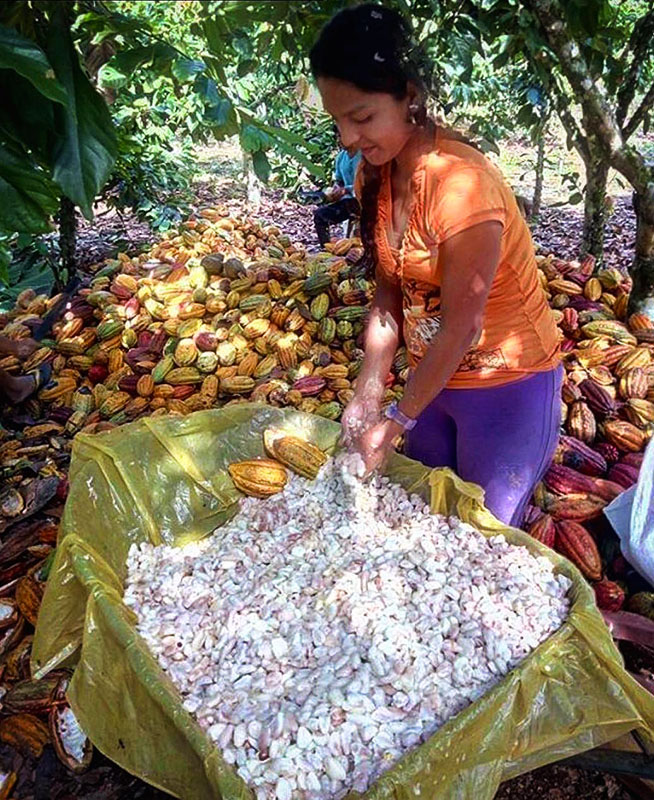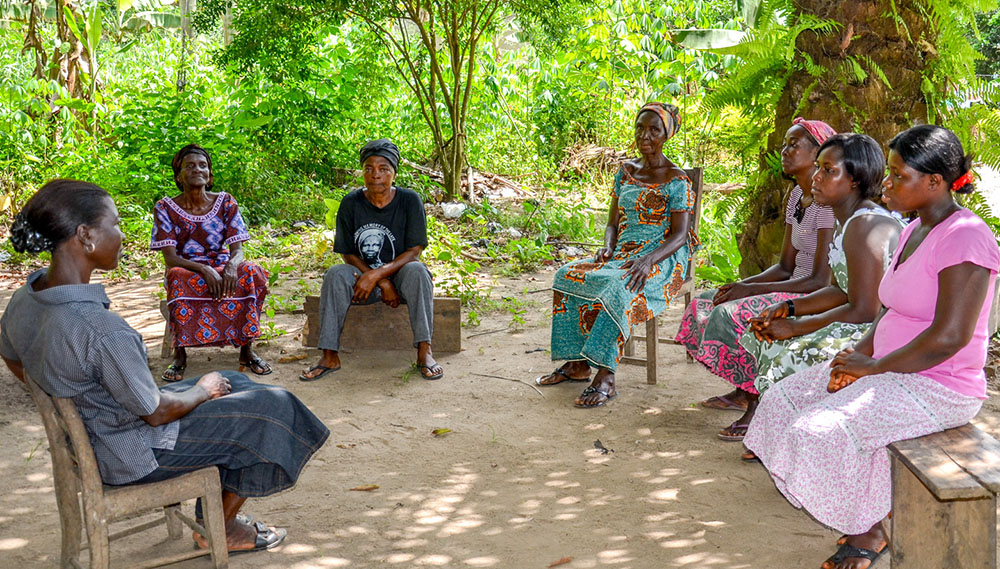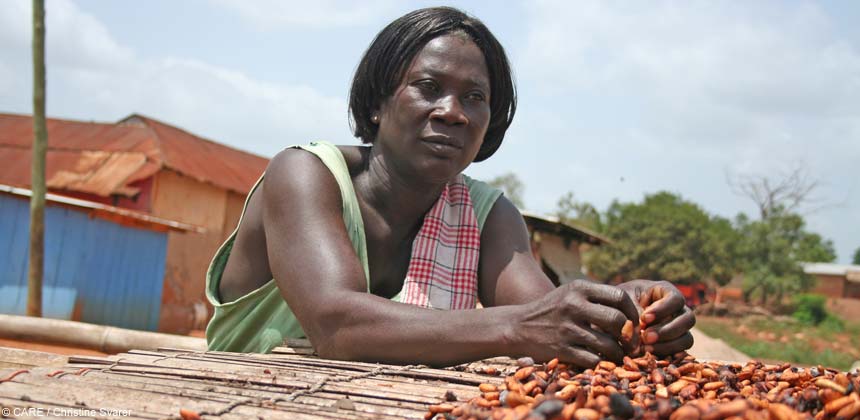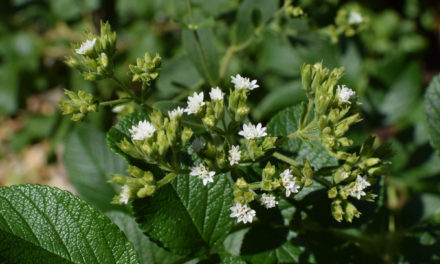by Rene Zimbelman
In last month’s issue, we started a conversation on the topic of gender inequality within the cacao industry. Female cacao farmers make significant contributions to the amount of cacao produced, yet seldom receive the recognition or compensation they should.
Make no mistake, the industry needs change, and there are multiple advantages to empowering these women. Not only will it positively impact the women and their communities, it will also increase the overall cacao supply, providing a boost to business as well.
Cyrille N’Guessan is a cocoa farmer and 49-year-old mother of five daughters, ages 8 to 30, from the village of Mamiankro.
Click the pic to read her story and view original image
This month, we bring to light various companies and organizations making efforts to address the gender inequality issue. Surprisingly, the “big” chocolate companies that we, as chocolate connoisseurs, don’t typically buy from, are actually addressing the issue to varying degrees, and in ways that just can’t be ignored, regardless of how we may feel about the end products.
This includes the “Big Three” — Mondelez, Nestle and Mars – who we feature in this article along with smaller organizations. Next issue we’ll move closer to the heart and soul of Chocolate Connoisseur, spotlighting the artisan chocolate companies we love.
Going “Behind the Brands”
Let’s begin with Oxfam. Introduced in last month’s article, the Oxfam organization focuses on injustices leading to poverty. In 2013, they launched the Behind the Brands campaign as a catalyst for change among the world’s top ten largest food and beverage companies.
Of these top ten, the “Big Three,” who according to Oxfam control thirty percent of the world’s chocolate market, were openly challenged to improve women cacao farmers’ rights – a challenge the three companies did indeed accept, to varying degrees.
Over a year later, Oxfam commissioned an independent evaluation of the progress these companies made in fulfilling their commitments. Though improvements were made, much more needed to be done to improve female farmers’ rights.
This need continues, of course, and you can find Oxfam’s continued evaluations (as recent as April 2016) on the Behind the Brands website.
Emerging Good Practice
For the sake of this article, we’ll zero in on a different evaluation, also conducted by Oxfam, which highlights –
“‘Emerging good practice’ (efforts being made) in areas that were identified as priorities for addressing women’s roles as cocoa farmers during a multi-stakeholder meeting held in Accra, Ghana, September 10-11, 2015, with cocoa traders, chocolate brands, cocoa producers’ organizations, government and NGOs. Using these conversations as a starting point, the report builds on them with additional research.”
The report largely focuses on emerging good practices coming out of Africa, given that Ghana and Côte d’Ivoire make up two of the world’s three largest cacoa-growing countries, and Nigeria is now working to revitalize its cacao sector as well.
Interestingly, Mondelez registered significant improvements in this Oxfam 2016 report, with much less mention of Nestle and no mention whatsoever of Mars.
Although in fairness, Behind the Brands’ April 2016 Company Scorecard gave both Mars and Nestle a five in the “women” category, meaning some progress has been made by these corporations in relation to women. The rating scale is one to ten, however, so although a five is progress, Mars and Nestle still have a long way to go.
Let’s focus on the positive and take a look at how the “emerging good practices” are already improving gender inequality within the cacao industry. It’s always encouraging to see progress!
Mondelez
Mondelēz International, Inc. is a global snacking powerhouse with net revenues in 2015 of approximately $30 billion. Its big names include billion-dollar brands such as Oreo, Nabisco biscuits, Cadbury, Cadbury Dairy Milk and Trident gum.
The company launched Cocoa Life in 2012, with goals of investing $400 million by 2022 to empower 200,000 cocoa farmers, and to reach one million community members in six key cocoa growing origins: Cote d’Ivoire, Ghana, Indonesia, India, the Dominican Republic and Brazil.
According to Oxfam –
“Among the brands producing chocolate, Mondelēz International has the longest track record of work on gender, through the early work of the Cadbury Cocoa Partnership, which started in 2008.”
As one of the longest standing multi-stakeholder cocoa initiatives, the Cadbury Cocoa Partnership (CCP) created substantive collaborations between industry, government, and non-profit implementation partners, all in efforts to boost sustainability of the cocoa supply, to increase productivity, and to address social issues in cacao-growing communities.
Although Cadbury started CCP, Kraft/Mondelēz took over the company in 2010, and then CCP’s work formed the basis of Mondelēz’s Cocoa Life program.
Through Cocoa Life’s partnership, communities come together to form cooperative societies. These, in turn, form district cooperatives. Membership is open to anyone who works on a cocoa farm, which is an important element of the program’s bylaws and governance, since many women do not own land.
Also, one Cocoa Life requirement, according to Oxfam, is that women must make up one-third of the cooperatives’ executive members.
Mondelēz and Cocoa Life also work to include women in community training and extension services. It’s an important core belief of the program that women need to lead the work, for the sake of female empowerment.
Mondelēz ensures that at least forty percent of trainers are women. According to Oxfam, “Cocoa Life has trained 218 women extension volunteers, to speak to the fact that women are often more comfortable learning from and sharing information with other women. These exchanges also aim to build confidence among female participants and position some of them for leadership in farmer’s groups and in local government institutions.”
The company also offers common sense solutions to communities in West Africa, where female farmers can’t use the pruning tools. As designed, some of the tools require a strength to operate that can exclude many women. Also, the machines used for pesticide application are designed to fit a man’s body, which makes it uncomfortable for women to operate such machinery.
Mondelez wisely realized this, and, as a result, adapted the tools and machines to allow female use as well, so women could more easily participate in all stages of cacao cultivation.
CARE and Cocoa Life
Founded in 1945, CARE is a leading humanitarian organization fighting global poverty, much like Oxfam. They place special focus on working alongside poor women, because according to CARE, when women are equipped with the proper resources, they have the power to help whole families and entire communities escape poverty.
Through its work with Cocoa Life, CARE is helping communities do their own assessments, creating Community Action Plans (CAPS) that help prioritize development projects in the community. These assessments help place greater focus on women’s roles in the future of the cacao industry.
A serious lack of access to loans and credit has been a major problem for female cacao farmers. Usually the barriers exist due to a lack of land ownership or other assets that can serve as collateral, a lack of credit history, or, in certain countries, laws that require a husband’s consent for a woman to take out a loan. Thankfully, things are gradually changing.
Cocoa Life, along with CARE, Voluntary Service Overseas (VSO) and World Vision Ghana (WVG), created Village Savings and Loan Associations (VSLAs), entities that provide both start-up funds for small businesses and capital for smallholder cacao farmers. The groups also help female cacao farmers and their families save during harvest season and carefully plan finances over the year to compensate for their sporadic income, isolated to specific times of the year.
The program (known as The Leadership & Business Skills for Women Fair Trade Producers Program) employs a trickle-down approach. A small group is trained in the cooperative and then they train women leaders who in turn train other women in their communities.
The training revolves around business and leadership skills as well as women’s legal rights. But Kuapa Kokoo realizes leadership training is not sufficient. It’s also important that women participate in decision-making forums, which can be difficult for some to attend. Kuapa Kokoo provides travel funds to remedy this situation, a big boon to female empowerment.
Amazingly, according to Oxfam –
“The trainings, along with the formation of district-level Gender Committees, has led to a seventy-five percent increase in the number of women putting themselves forward for the National Executive Council (NEC) in 2014. As a result, forty-six percent of Kuapa Kokoo’s current NEC members, including the new president, are women.”
In addition, Kuapa Kokoo formed its own credit union, allowing farmers to access previously unavailable loans.
World Cocoa Foundation (WCF)
While running farmers’ field schools, the World Cocoa Foundation (WCF) discovered that, because of limited time and cultural constraints, it can be difficult to fully engage women in the learning process. Their solution? A Video Viewing Club. These video viewings, part of the Sustainable Tree Corps Program, brought female cacao farmers together to learn technical skills, and to hopefully teach other women how to implement the training as well.
By 2010, 1,600 farmers in Côte d’Ivoire and Ghana were trained through the Video Viewing Clubs.
WCF also provides an online toolbox on their website, for cacao industry partners to access. This toolbox includes facts, tools, and an outline on how to use the website to increase understanding of address gender inequality issues and how to address them.
Or click here to save BIG and pick up an Annual Subscription today!
We’ll be back in September with the third and final installment in this series…
References
http://www.triplepundit.com/podium/twitter-chat-women4cocoa-empowering-women-cocoa-communities/
https://www.oxfamamerica.org/static/media/files/Womens_Rights_in_the_Cocoa_Sector_paper.pdf









